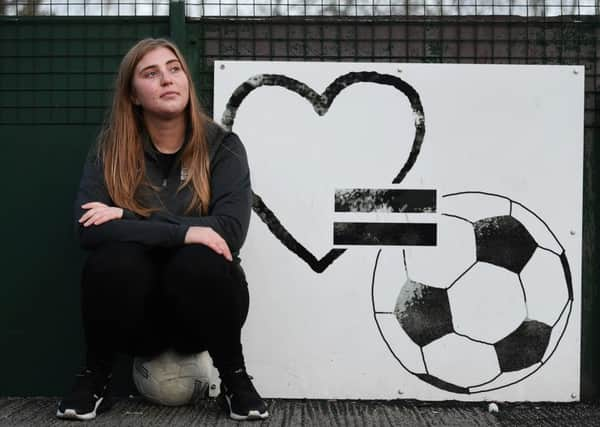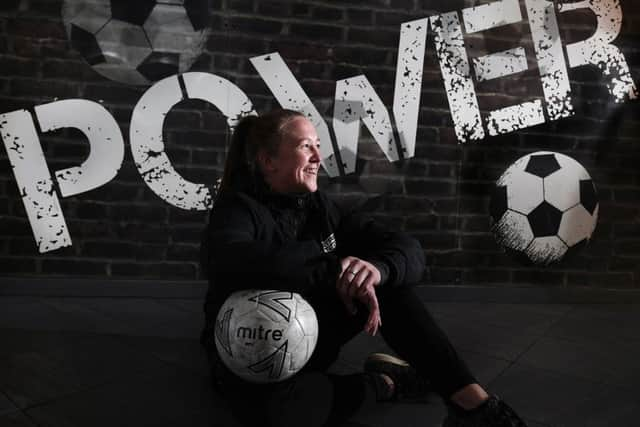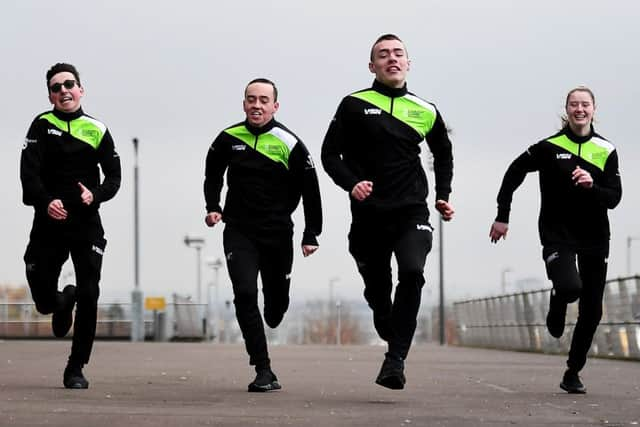Insight: Changing the Game to break a losing streak


“I was raging that I had been left alone with her,” Cooper admits. “I couldn’t look at her because I was embarrassed. She asked me really nice questions, but I was determined not to give anything away.”
Rhind, a former heroin addict, runs a women-only football programme at Glasgow’s Street Soccer: a charity which tackles social exclusion through football. Cooper, now 24, had been brought along for the first time by a support worker from the mental health charity SAMH. She had just been discharged after four years in a locked ward in a psychiatric hospital. Having been abused as a child, she was wary of men.
Advertisement
Hide AdAdvertisement
Hide AdIn an effort to gain her trust, her male support worker bought a football and the pair began to have a kick-about together in the mornings. Gradually some of the other male support workers joined in. Cooper began to feel less threatened.


One day, the support worker suggested she might like to go along to Street Soccer – which led to the tense stand-off with Rhind . That was two years ago. Today, Rhind and Cooper are friends; and Cooper spends every day at the charity’s Powerleague base in Townhead. “In my life most people, if they didn’t get me the first or second time, would just walk away, but Sarah kept trying the 10th time, the 11th time until finally we talked. I think I told her my life story in 15 minutes.”
Perhaps the reason they eventually bonded is that they had much in common. Rhind had lost years, and her sense of self, to her addiction. While undergoing a six-month rehab with Phoenix Futures, she was asked what activities she would like to take part in.
“I couldn’t think, but then I remembered the one thing I had always been good at was football.” She started coming to Street Soccer and couldn’t stop.
“I still have rubbish days, but now I come and play football. You go on the pitch and for 90 minutes you forget all your troubles and feel good,” she says.


For Cooper it has brought a sense of belonging. “It’s being part of something – it’s not so much a team as a family,” she says. “I had nothing to be part of. Here, I was valued and mattered.”
Rhind and Cooper have suffered more than most. Their lives are not typical, but studies have established participating in sport has myriad benefits, not only for the individual, in terms of general physical and mental health, but in building more cohesive communities.
Despite this, it is a struggle to persuade people to take as much exercise as they should. Last week a study conducted by the World Health Organisation reported the majority of adolescents were not sufficiently active and were putting their current and future health at risk. The report, published in The Lancet Child & Adolescent Health Journal, found that more than 80 per cent of school-going adolescents globally (85 per cent of girls and 78 per cent of boys) did not meet current recommendations of at least one hour of physical activity per day.
Advertisement
Hide AdAdvertisement
Hide AdAs for Scotland, it lags behind most other European countries. According to research carried out by the Observatory for Sport in Scotland (OSS) – an institute which aims to gather data on which policy can be built – the number of people engaging in physical activity hasn’t changed since 2007. The proportion of children aged 2-15 meeting the UK guidelines (150 minutes of moderate activity a week) is 79 per cent for boys and 72 per cent for girls. The proportion of adults meeting the guidelines has risen slightly from 62 per cent to 65 per cent.
This may not sound too desperate. The problem is that the number of young people exercising a lot drops steeply from 10 to 13 and even more steeply between 13 to 15. Both the WHO and the OSS reports suggest this drop-off is much greater for girls (where it falls to 11 per cent) than boys (where it falls to 24 per cent). This gender divide continues through life, with 71 per cent of adult men meeting the health guideline compared with 60 per cent of women. This is despite the fact that the term “physical activity” has been widened to include walking and that “walking” makes no distinction between organised rambling and the journey to the bus stop every morning.
There is also an economic divide. People living in the most deprived areas of Scotland are much less likely to participate in sport (42 per cent, excluding walking, in 2017) compared with those living in the least deprived areas (65 per cent).
Tomorrow and Tuesday, the OSS is hosting a summit, Changing the Game, at Tynecastle Stadium in Edinburgh. Rhind and Cooper will be speaking; so will Billy Garrett, sports operations manager at Glasgow Life, and Remco Hoekman and Henrik Brandt, the directors of similar research institutes in Holland and Denmark, who will talk about the ways in which their countries set about improving a nation’s fitness levels.
“We are among the worst for physical activity in the developed world, have the lowest life expectancy in the UK and are the only UK country where life expectancy suffered a tiny drop last year,” says David Ferguson, executive director of the OSS.
“We are not bringing all the research together to flagellate ourselves, but so we can create a much more accurate picture in Scotland, and share solutions to help government, local authorities, health, education and communities to create a more cohesive, sustainable culture around tackling that in all parts of the country.
“It is about changing our current approach of hand-outs of funding for great projects here and there, which then get cut after a year or two, with no strategic vision. That’s been our approach for some time in Scotland, and it’s not changing the trends.”
When we think of Holland, we tend to associate it with high levels of physical activity, probably on account of all the bikes. When I visited Amsterdam earlier this year the morning rush hour resembled the Tour de France as thousands of commuters pedalled their way along the city’s ubiquitous cycleways.
Advertisement
Hide AdAdvertisement
Hide AdHolland is indeed a place where physical activity levels are high – it has the fourth highest sports participation rate in Europe – but this state of affairs has only come about through a cultural shift combined with a long-term strategy.
“When I started to investigate what was happening in Holland, people kept telling me about a woman called Erika Terpstra,” says Ferguson. Terpstra is a former Olympic swimmer-turned-politician who became under-secretary for health, welfare and sport in 1994. “She said on her first day in the job she was flanked by 30 or 40 people from health and welfare telling her about major problems coming their way in obesity, physical inactivity and mental health. The first thing she thought was: ‘We have all these health advisers, all these communications teams, all these people from welfare: why is there no-one here from sport?’
“The answer was along the lines of: ‘Look, Minister, this isn’t about fun and games,’ so she said: ‘OK, that attitude has to stop now because sport is not just fun and games, it’s about social cohesion.’ She said someone had to stick a flag in the ground and say ‘Let’s see sport as a tool for improving health’.”
The challenge was to get hold of the statistical evidence to back up her approach. Terpstra approached two universities, but they came back with wildly diverging figures for sports participation and so, in 2002, the government set up the Mulier Institute.
In fact, the tradition for investing in sports predates Terpstra, says Hoekman, who is the director of the Mulier Institute and on the OSS board. “From WWII, the provision of sports facilities was a priority, not for the elite sports like tennis – it’s up to the people in these higher socio economic groups to build their own facilities – but for football and other sports practised by the lower socio-economic strata because [the government] saw it as responsible leisure time. If [young people] were playing sport they wouldn’t fall into crime or get drunk.
“From 1994 on, however, there was a change in focus. Before that sport was seen as good for the individual, but from then on it was also good for society. Sport was considered as positive and a means of reaching goals in other policy domains.”
This meant more money. Later on that money trickled down to the local level. “Local authorities have been pretty successful in positioning sport within the municipality as being a cheap policy instrument that is very successful in improving health and encouraging integration.” Sport was considered so important, it rode out the recession. “It was seen as valuable and so budgets were largely untouched,” says Hoekman.
This is not true in Scotland. In 2017, Sport Scotland announced sports funding in the country was facing a 20 per cent drop over three years thanks to cuts in government spending and falls in the sales of National Lottery tickets. And Brian McLaren from the economic consultancy Ekos is expected to tell the summit that in Scotland local authority funding for sport has gone down every year for the past 12 years.
Advertisement
Hide AdAdvertisement
Hide AdThe reason for that is that, unlike, say, education funding, sport and leisure funding is not ring-fenced, and so is an easy target. This impacts on the provision of facilities. “We have a big national database, so we can see sports facilities are well represented in the low status neighbourhoods,” says Hoekman. “From what I have seen in studies of Glasgow and other Scottish cities, this is not the case.”
Ferguson says the annual local authority cuts mean more closures to come. “I know this because I have spent time with the leisure trusts that have been fighting those closures over the last few years,” he says. He was one of those leading the fight-back when Finance Secretary Derek Mackay said the government planned to remove rates relief from leisure trusts. “If they’d done that, Glasgow would have faced a bill of £16m a year. Sixty percent of facilities would have closed because they are already on the edge,” he says.
The OSS plans to conduct a national survey on sports participation and physical activity so the Scottish Government has accurate figures on which to base its policies. But it has also been asked to help create a new model for community sport delivery, a project that will be led by Glasgow Life.
“Glasgow Life has some really big facilities, such as the Emirates Arena in Dalmarnock, which cost a lot to run,” says Ferguson. “It receives more funding than any other leisure trust, but even so, Glasgow can’t afford it any more. That’s going to be a key talking point at the summit: how do we find a new model of delivery to maintain these community facilities?”
Glasgow Life is already taking a lateral approach to increasing sports participation in areas of multiple deprivation. One example of this is Walking Bear – three events which saw 200 or more families exploring green areas in Bridgeton, Camlachie, Parkhead and Dalmarnock.
Ninety-four per cent of the families were from areas of multiple deprivation and 20 per cent of the adults were not meeting the guidelines for recommended physical activity. Engagement was encouraged via a Walking Bears Facebook page which allowed those involved to post stories and photographs of their adventures.
Another successful scheme is the Coach Core programme run by Glasgow Sport in partnership with the Royal Foundation. Coach Core involves giving young people who are not in employment or Higher Education the chance to gain a Level 2 SVQ in sports training while being paid a wage and delivering sport to others. Since 2013, 80 young people have completed the programme. All of them have gone on to Higher Education or employment.
Last week I met four of this year’s crop: William Gray, 19, and Ajay Green, Dion Polland and James Palmer, all 18, at the velodrome in the Emirates Arena. After 12 weeks, they seem happy, confident and buzzing about their course, some of which involves working with children with disabilities.
Advertisement
Hide AdAdvertisement
Hide Ad“Mondays and Fridays we go in the office and catch up on paperwork or do stuff like safeguarding, then on Tuesday, Wednesday and Thursday, that’s when we do our chosen sports out of the centre,” says Green. “For example, I do disability swimming, so on a Tuesday I am at Pollok pool teaching kids how to swim.”
The teenagers love getting fit and helping others to get fit at the same time. “There are so many sports out there,” says Gray. “You can even go walking. You are getting active and meeting new people from different areas. You are starting to build relationships – so there are social benefits too.”
Polland was helping out at her local boxing club when someone told her about the scheme; now she goes into schools to help coach P4/5s in football too.
“I think right now in this world, mental health is a huge issue,” she says. “If you are out, keeping yourself busy, taking your mind off things while getting fit, it’s good for your health, but it’s good in the social sense as well.”
Coach educator Sean Watson says Coach Core targets the hardest-to-reach young people. “We have made our recruitment process really informal. We are measuring their confidence, attitude, motivation and enthusiasm rather than their actual skill set so everything is done on a group basis rather than through one-to-one interviews,” he says.
As sports operations manager at Glasgow Life, Billy Garrett is the man responsible for these initiatives. He has also been charged with coming up with a new model of provision in an era of austerity. He believes we need to emulate Holland and Denmark by properly acknowledging the role sport plays across health, education and the criminal justice system. “It will be good to get the opportunity to talk collectively about the importance of sport and physical activity because I am not sure that is recognised across the spectrum,” he says.
“If you think of this from a Glasgow perspective, we still have a lot of challenging health indices. We know 65 per cent of the population are overweight and it’s not uniform. If you get on a train in Jordanhill and do a short journey to Bridgeton, the average life expectancy of a man drops significantly at every station.
Garrett says Glasgow is already benefiting from efforts to shift resources from treatment to prevention, but more needs to be done. “More than 40 per cent of current public sector expenditure in Scotland goes on the health service,” he says.
Advertisement
Hide AdAdvertisement
Hide Ad“That figure has been increasing and is set to increase more. There are legitimate reasons for this, but to what extent is it financially sustainable?”
“We have about a dozen projects on the go at the moment, but the question is this: How do we upscale our East End model to the next level? How do we test it on a really significant scale and really start to crack this problem?”